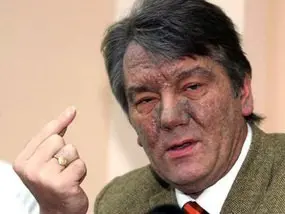Still, scientists can’t tell where the chemical came from and who was ultimately behind the poisoning of Yushchenko, now the president of Ukraine.
After Yushchenko fell seriously ill following a dinner in Kiev in September 2004, doctors found dioxin levels in his blood more than 50,000 times higher than normal.
Hundreds of dioxins are produced during manufacturing processes that use chlorine, like herbicides, paper and pulp bleaching, and most people in the West have some level of dioxins naturally in their body.
But the type of dioxin doctors found in Yushchenko, TCDD, was the most lethal kind; it was also used in Agent Orange, a herbicide sprayed by U.S. troops during the Vietnam War that has been linked to numerous health problems.
After Yushchenko’s poisoning, he suffered severe gastrointestinal problems and his face was temporarily disfigured.
In a study published online Wednesday in the medical journal Lancet, Yushchenko’s doctors report that it took about 15 and a half months for his body to get rid of half of the dioxin, much quicker than the years that other experts had estimated it would take.
His doctors said that was due to the treatment they gave him, though they would not discuss exactly what they did.
“The level of (dioxin) in Yushchenko’s body shows that he was deliberately poisoned,” said John Emsley, of the department of chemistry at Cambridge University. Emsley was not linked to the Lancet study.
“I cannot believe anyone would willingly take (dioxin) knowing the terrible skin condition it produces,” he said, adding it is most visible on the face, but often affects other areas, including the genitals.
The dioxin used to poison Yushchenko could have been produced in numerous laboratories. And because it was a purified version that has no natural source – unlike the polonium used to kill Kremlin critic Alexander Litvinenko in London in 2006 – scientists don’t have any clues to trace its origins.
Doctors at the University of Geneva and the Swiss Centre for Applied Human Toxicology took blood and fat samples from Yushchenko for at least three years to track how fast his body was eliminating the chemical. Dioxin is usually stored in the body’s fat and liver.
The doctors found that about 60 percent of the dioxin eliminated from his body during that time was not metabolized. Most of the dioxin was excreted through feces, though doctors also found traces of it his blood and urine.
Dr. Jean Saurat, who led Yushchenko’s treatment and the Lancet study’s lead author, said the lesions on Yushchenko’s face were the result of his skin trying to metabolize the dioxin. “The skin attracted the (dioxin) and then became like a factory trying to clear the body of the poison,” he said.
Saurat said there is no sign that Yushchenko is now more vulnerable to cancer because of the poisoning.
Experts said while it was obvious Yushchenko was poisoned, the scientific analysis did not provide any more clues to who was responsible.
Yushchenko, one of pillars of Ukraine’s “Orange” democratic revolution, was poisoned as he campaigned to curb Russian influence on the Ukraine and to strengthen ties with the West.
You can also highlight the text and press Ctrl + Enter




